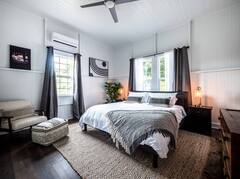Getting up at 3 AM is not my idea of fun, especially when I am on vacation, but the sunrise over the crater made the hour and lack of sleep worthwhile! Haleakala National Park, on the island of Maui, Hawaii, encompasses 33,000 acres (134.5 sq km) with almost half of this being designated a wilderness area, or 19270 acres (78 sq km).
Haleakala is a special place with ancient stories and modern Hawaiian culture closely tying the bond between the land and its people. The national park is home to multiple endangered species, some of which exist nowhere else on earth. The stark volcanic landscape, sub-tropical rainforest, soft breezes through the bamboo forest, and warm sun on your back as you hike or horseback will renew your body and soul.
A little history

The Haleakala volcano was originally a part of the Hawaii National Park along with two volcanoes on the island of Hawaii – Mauna Loa and Kilauea. In 1961, Haleakala National Park separated from the park on the main island. In 1980, the International Biosphere Reserve was designated as a part of the national park on Maui.
Haleakala is Hawaiian for “house of the sun.” According to a local Hawaiian legend, the semigod Maui imprisoned the sun on Haleakala to lengthen the days because he felt the days went by too quickly to get anything done.
The national park is divided into very distinct sections or districts that are not connected by a road. The summit area of Haleakala volcano, now dormant, is considered East Maui; it last erupted about 1500 AD. The coastal area, Kipahulu, is along the ocean waters. Even though divided into two sections, the park averages 1.5 million visitors annually.
The summit

The summit is sacred to Native Hawaiians and still used for many cultural practices. Visitors should be quiet and respectful of the area at all times.
The main feature of this part of the park is obviously the famous Haleakala Crater. At a diameter of 6.9 miles (11.25 km) across and 2 miles (3.2 km) wide, the crater is considered huge by geological standards. The deepest part of the crater measures 2,600 feet (790 m) deep.
The summit elevation is 10,023 feet (3,055 meters). It takes 2 – 4 hours to reach the summit depending on time of day, traffic, and weather. The road to the summit is well maintained but full of switchbacks, curves, steep roads, and of course, beautiful viewpoints. Bicycles are also very common on the highway during the daylight hours.
Temperatures at the summit can be at least 20 degrees F colder than at sea level and are often below freezing, especially at sunrise. A visitor’s center with parking and restrooms is located near the summit. At the summit itself is another parking lot and simple observatory without facilities.
The summit, especially on a clear, cold night, is an amazing place to view the sunrise. The colors as the sun peeks over the horizon are both subtle and vivid. Time seems to creep by as you wait for the sun to rise, but appears to accelerate once the sun peeks over the horizon. The speed of the breaking dawn ties to the Hawaiian legend mentioned earlier — the semigod wanted the daytime to last longer. An equally spectacular sunset can be viewed from the crater rim.
The interior of the crater displays many volcanic features including various rock formations and cinder cones. Two main trails lead into the crater from the summit area, the Halemau’u and Sliding Sands.
Reservations can be made for horseback rides from the rim to the floor of the crater (with lunch served at the basin). Allow 6 hours minimum for this wonderful adventure. Horses are available for all levels of skills with expert guides to provide insight along the trail. The trail is sometimes steep so this is not for the faint of heart. There are also no services (this includes no restrooms) on the trail. Fees vary depending on duration and type of ride requested.
Hikers frequently explore the crater on foot using these trails as well. There are three cabins, which must be reserved in advance, that hikers can spend the night in if they are planning extended hikes in the area. An overnight stay provides a great opportunity to stargaze.
The Observatory at the rim

The Haleakala Observatory located near the visitor center is above the tropical inversion layer. The location permits some amazing viewing conditions when the skies are clear. One of the Observatory missions, the Maui Space Surveillance System (MSSS), tracks satellites and debris orbiting the Earth. The Observatory is on a gated road just past the summit and well worth a visit while at the summit.
Haleakala is one of the best places in the world to see incredibly clear views of the night sky. The observatory at the summit offers a wealth of information about space and the sky views as well as educational programs. Many local merchants (outside the park) rent binoculars and telescopes for visitors wanting to engage in a little star watching while in the area.
You might be interested in these Airbnbs!
Habitat tidbits

Located on the drive to the summit, Hosmer’s Grove is an interesting habitat to explore. A unique forest of alien trees including deodar from the Himalayas, sugi from Japan, eucalyptus from Australia, and several species from North America, including pine, spruce, cypress, and fir, are found in this grove. These tall alien trees prevent native plants and trees from growing by limiting the amount of light available at ground level. Many of these trees appear to reach into the sky with their heights.
Many endangered species make their home in the natural habitat of the park, in fact, more than any other national park in the United States. All of the plants and animals now present on the island were brought through pioneers or naturally (through the air or sea).
For example, the Nene, Hawaiian geese, can be found in their natural habitat on Haleakala. The story of the Nene is remarkable for their recovery from extinction. These birds completely died out from the park. But, in 1946, a local Boy Scout troop carried young birds into the crater in their backpacks to re-introduce the species to the habitat. The geese have thrived and can be found throughout the summit park area.
Another example of a now extinct plant, is the Haleakala silversword, which used to cover the volcano slopes to such a degree the mountain looked as if it were covered with snow (there is no snow in Hawaii).
Kipahulu

The second section of the park is Kipahulu lying in the lower Kipahulu Valley. Visitors cannot drive directly to this section from the summit area, but instead must take a long winding coastal road around the windward coast of the island. The drive to Kipahulu is a 4 hour drive from Kahului along the Hana Highway.
The waters of the Kipahulu district are home to many endemic gobies and other fish that evolved from ancient salt water ancestors. Swimming in the streams is not recommended, but is permitted.
Much of the area is designated as the Kipahulu Valley Biological Reserve and closed to the public to preserve the fragile native plant and animal species of the rainforest. More than two dozen pools along Palikea Stream in the gulch ʻOheʻo contain rare native freshwater fish. Visitors may choose to hike to these pools, or they may choose to hike a trail that takes visitors up to the base of Waimoku Falls.
Be prepared

Both the Summit and Kipahulu districts are remote, so plan accordingly. Emergency services can take up to an hour to arrive at either district. The summit exceeds 10,000 feet (3,052 m), which may present breathing challenges to those with respiratory or cardiac health concerns.
There is no food, beverages (other than drinking water), or gasoline in the park. Bring plenty of water and snacks or food with you for your trip into the park. The park is open 24 hours a day, 365 days a year except during extreme weather events.
Be sure you bring sun protections including a hat, sunglasses, and sunscreen as the sun can be intense in either area. In addition, prepare for a variety of weather conditions as the weather may rapidly change at any time of the year. It is wise to carry rain gear, shorts and long pants, and a jacket in your travel kit.
Sturdy shoes are an absolute must for either district, especially if hiking. Since emergency services are far away, the last thing you want is an unexpected emergency you could have prevented.
Flash floods and sudden rock falls can occur at any time of year so be aware of your surroundings.
Sunrise to sunset is amazing
Maui is an amazing island with Haleakala National Park as its crowning jewel. Sunrise or sunset is gorgeous and worth the drive to experience the amazing views.
History
Get Trip101 in your inbox
Unsubscribe in one click. See our Privacy Policy for more information on how we use your data




















Create an account to